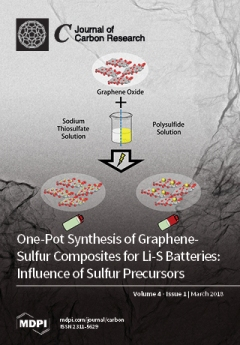Open AccessArticle
Nitrogen-Doped Hollow Carbon Spheres with Embedded Co Nanoparticles as Active Non-Noble-Metal Electrocatalysts for the Oxygen Reduction Reaction
by
Ruohao Xing 1,2, Yao Zhou 1, Ruguang Ma 1,*, Qian Liu 1,3,*, Jun Luo 2,3, Minghui Yang 4,* and Jiacheng Wang 1,3,*
1
State Key Laboratory of High Performance Ceramics and Superfine Microstructure, Shanghai Institute of Ceramics, Chinese Academy of Sciences, 1295 Dingxi Road, Shanghai 200050, China
2
School of Materials Science and Engineering, Shanghai University, 99 Shangda Road, Shanghai 200444, China
3
Shanghai Institute of Materials Genome, Shanghai 200050, China
4
Ningbo Institute of Materials Technology and Engineering, Chinese Academy of Sciences, Ningbo 315201, China
Cited by 1 | Viewed by 6243
Abstract
Transition metal (Fe, Co, Ni) complexes on carbon nanomaterials are promising candidates as electrocatalysts towards the oxygen reduction reaction (ORR). In this paper, nitrogen-doped hollow carbon spheres with embedded Co nanoparticles were successfully prepared via a controllable synthesis strategy. The morphology characterization shows
[...] Read more.
Transition metal (Fe, Co, Ni) complexes on carbon nanomaterials are promising candidates as electrocatalysts towards the oxygen reduction reaction (ORR). In this paper, nitrogen-doped hollow carbon spheres with embedded Co nanoparticles were successfully prepared via a controllable synthesis strategy. The morphology characterization shows that the hollow carbon spheres possess an average diameter of ~150 nm with a narrow size distribution and a shell thickness of ~14.5 nm. The content of N doping ranges from 2.1 to 6.6 at.% depending on the calcination temperature from 900 to 1050 °C. Compared with commercial Pt/C, the Co-containing nitrogen-doped hollow carbon spheres prepared at 900 °C (CoNHCS-900) as an ORR electrocatalyst shows a half-wave potential shift of only ∆E
1/2 = 55 mV, but a superior stability of about 90.2% maintenance after 20,000 s in the O
2-saturated 0.1 M KOH at a rotating speed of 1600 rpm. This could be ascribed to the synergistic effects of N-containing moieties, Co-N
x species, and Co nanoparticles, which significantly increase the density of active sites and promote the charge transfer during the ORR process.
Full article
►▼
Show Figures





